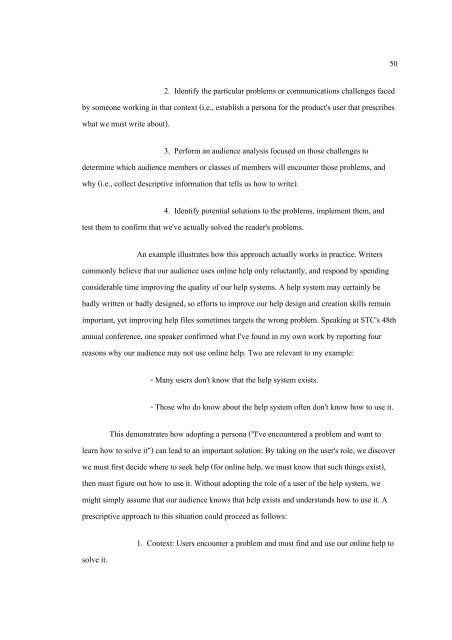Graduate Students of Kasetsart University
Graduate Students of Kasetsart University
Graduate Students of Kasetsart University
You also want an ePaper? Increase the reach of your titles
YUMPU automatically turns print PDFs into web optimized ePapers that Google loves.
2. Identify the particular problems or communications challenges faced<br />
by someone working in that context (i.e., establish a persona for the product's user that prescribes<br />
what we must write about).<br />
3. Perform an audience analysis focused on those challenges to<br />
determine which audience members or classes <strong>of</strong> members will encounter those problems, and<br />
why (i.e., collect descriptive information that tells us how to write).<br />
4. Identify potential solutions to the problems, implement them, and<br />
test them to confirm that we've actually solved the reader's problems.<br />
An example illustrates how this approach actually works in practice. Writers<br />
commonly believe that our audience uses online help only reluctantly, and respond by spending<br />
considerable time improving the quality <strong>of</strong> our help systems. A help system may certainly be<br />
badly written or badly designed, so efforts to improve our help design and creation skills remain<br />
important, yet improving help files sometimes targets the wrong problem. Speaking at STC's 48th<br />
annual conference, one speaker confirmed what I've found in my own work by reporting four<br />
reasons why our audience may not use online help. Two are relevant to my example:<br />
- Many users don't know that the help system exists.<br />
- Those who do know about the help system <strong>of</strong>ten don't know how to use it.<br />
This demonstrates how adopting a persona ("I've encountered a problem and want to<br />
learn how to solve it") can lead to an important solution: By taking on the user's role, we discover<br />
we must first decide where to seek help (for online help, we must know that such things exist),<br />
then must figure out how to use it. Without adopting the role <strong>of</strong> a user <strong>of</strong> the help system, we<br />
might simply assume that our audience knows that help exists and understands how to use it. A<br />
prescriptive approach to this situation could proceed as follows:<br />
solve it.<br />
1. Context: Users encounter a problem and must find and use our online help to<br />
50

















